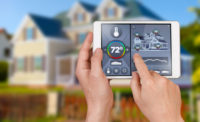The Internet of Things (IoT) has permeated nearly every facet of the HVAC industry. Customers can connect their phones to their thermostats, boilers, furnaces, and more, all because of industry evolution and the consistent demand to push the boundaries of what is possible. That evolution is making its way to the geothermal corner of the marketplace.
The geothermal industry has a lot going on at the moment. Federal tax incentives, or lack thereof (story on Page 1), currently dominate the discussion, but manufacturers are releasing new, intelligent geothermal products all the time.
With the global smart home market poised to grow at a compound annual growth rate (CAGR) of around 15.2 percent over the next decade to approximately $186.17 billion by 2025 (per Research and Markets), it only makes sense for geothermal to innovate accordingly.
GEOTHERMAL GENIUS
“The IoT is a huge part of the industry overall and one that will get more focused as we go along, including in geothermal,” said Jesse Robbennolt, P.E., product manager, Modine Mfg. Co. “What we see as a challenge is the current lack of a backbone in the home network. What I mean by that is we see independent networks working throughout a home. The HVAC is on one protocol, lighting is on another, and smart appliances are on a third one. There is no cohesive network backbone, so those components cannot talk to one another. Homeowners then have no central portal to their homes.”
Joey Sung, controls product manager, Bosch Thermotechnology, said the company is in the process of developing geothermal products with IoT connections and capabilities.
“We are hoping to get at least the initial versions of them out in early 2018,” he said. “This is definitely on our product roadmap, and we understand that is where the market is headed.”
Sung also said the demand for IoT-capable products is coming from both customers and contractors.
“For contractors, having an IoT device is really about monitoring installed equipment, which helps to balance their workloads while providing excellent customer service that the users expect from their contractors,” Sung said. “Geothermal contractors told us that they really want connected devices to ensure they can continue the monitoring and optimization of the installed equipment base.”
Last year, Carrier Corp. introduced its GC and GZ residential geothermal models, which are compatible with Carrier’s Infinity® Touch™ control.
“When used with the Infinity Touch control, GC and GZ unit operation includes remote access, diagnostics, self-configuration, advanced comfort control and energy efficiency, Ideal Humidity System™ technology, zoning capability, SmartEvap™ technology, and ComfortFan™ technology,” said Kent Kuffner, geothermal product manager, Carrier Corp. “By combining the natural energy savings of geothermal with the Carrier-enhanced intelligence found in the Infinity Touch control, customers can enjoy even greater energy savings and year-round comfort with remote access and advanced system control.”
REALIZING EXPECTATIONS
One of the realities of the development of IoT-capable products throughout HVAC is that customers can grow complacent with products and their baseline expectations can become more complex. What was once new and novel, such as touchscreen thermostats and remote monitoring, becomes a standard expectation from new products.
“Typically, high-end systems, such as our Trilogy 45, tend to have advanced communication capabilities,” said Naveen Halbhavi, director of marketing, ClimateMaster Inc. “These systems are commonly found in large homes with multiple zone controllers, so homeowners expect internet-enabled connectivity and wireless access to all critical comfort parameters. This has become a basic expectation, so we make it available by default.”
Robbennolt also believes IoT connection has become a basic demand of customers.
“They want to control the temperature of their homes from their smartphones,” he said. “As it gets further down the road, we will be ready to tie into it when the backbone truly emerges and a nonproprietary communications protocol to tie all the smart products in the home together gets chosen.”
As geothermal products are generally geared toward the higher end of the marketplace, consumers may already expect more from their IoT-connected devices than most HVAC customers.
“On the consumer side, through connected thermostats, we see they value having connected HVAC equipment,” said Sung. “Of course, not all consumers are excited about these connected devices in the market. However, geothermal products, which are targeted largely at the higher end of the market, see more benefits of connectivity due to the relative cost of the upgrade compared to the cost of the unit. I believe the whole industry is really moving firmly into IoT connectivity.”
Robbennolt also pointed out the customers themselves are getting smarter, which is affecting the marketplace. “We are seeing more acceptance and awareness of geothermal by end users coming directly to us researching the products,” he said. “Consumers are getting much smarter, and they are leveraging the power of the internet and doing their research before even approaching a contractor or dealer to have conversations. They know things about the products and generally have something picked out beforehand. The level of engagement is new in geothermal and other segments of the market.”
There are certainly issues to be wary of as the IoT grows both in the industry at large and specifically within geothermal. Robbennolt highlighted the potential concern of having malicious software gain access to a whole network and then wreak havoc on anything and everything in the building.
“It’s something we have to be careful of, but once that network backbone gets identified, you will see a flurry of things happening,” he said. “The IoT will stabilize and mature once that happens.”
As that market stabilizes and matures, consumer demand for smart products in geothermal will only increase.
“Throughout HVAC, end users and installation/service professionals are looking for more access to data,” said Sung. “We expect major growth in geothermal and the IoT over the next few years. This growth will only accelerate because it’s still at the early stages of development.”
Publication date: 4/3/2017
Want more HVAC industry news and information? Join The NEWS on Facebook, Twitter, and LinkedIn today!












